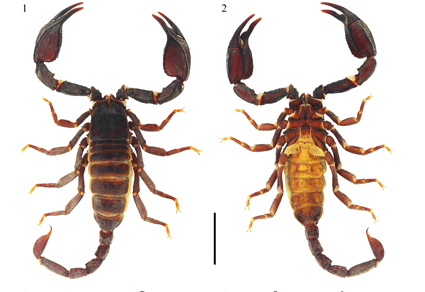Abstract
A new species of Scorpiops Peters, 1861 is described from Wuxi and Wushan County, Chongqing City, China. The new species is mainly characterized by a moderate size, in relation to the other species of genus, with dark reddish-brown to reddish-black coloration; 15–17 (usually 17) external trichobothria (5 eb, 1–2 esb, 1–2 em, 4 est, 4 et), 8–11 (usually 10) ventral trichobothria in the pedipalp patella and 4–5 (usually 5) ventral trichobothria on chela; pedipalp chela fingers are scalloped in males and nearly straight in females. With the present description the number of known species of Scorpiops recorded from China is raised to 33.
References
Di, Z.Y., Wu, Y.L., Cao, Z.J., Xiao, H. & Li, W.X. (2010) A catalogue of the genus Euscorpiops Vachon, 1980 (Scorpiones: Euscorpiidae, Scorpiopinae) from China, with description of a new species. Zootaxa, 2477, 49–61.https://doi.org/10.11646/zootaxa.2477.1.4
Di, Z.Y., He, Y.W., Cao, Z.J., Wu, Y.L. & Li, W.X. (2011) The first record of the family Euscorpiidae (Arachnida: Scorpiones) from Central China, with a key of Chinese species of the genus Scorpiops. Euscorpius, 118, 1–9.https://doi.org/10.18590/euscorpius.2011.vol2011.iss118.1
Hjelle, J.T. (1990) Anatomy and morphology (p. 9–63). In: Polis G. A. (Ed.), The Biology of Scorpions. Stanford: Stanford University Press, 587 pp.
Li, W.X., Wu, Y.L., Cao, Z.J. & Di, Z.Y. (2016) Scorpion biology and toxins. Science Press, Beijing, China, pp. 235–239.
Kovařík, F., Lowe, G., Stockmann, M. & Šťáhlavský, F. (2020) Revision of genus-group taxa in the family Scorpiopidae Kraepelin, 1905, with description of 15 new species (Arachnida: Scorpiones). Euscorpius, 325, 1–140.
Lourenço, W.R. & Ythier, E. (2022) A new species of the genus Scorpiops Peters, 1861, subgenus Euscorpiops Vachon, 1980 from Laos (Scorpiones: Scorpiopidae). Faunitaxys, 10 (27), 1–9.
Lv, H.Y. & Di, Z.Y. (2022) Scorpiops lourencoi sp. nov., the revalidation of Scorpiops atomatus Qi, Zhu & Lourenço, 2005, and the redescription of Scorpiops tibetanus Hirst, 1911 (Scorpiones, Scorpiopidae) from China. Zookeys, 1132, 189–214.https://doi.org/10.3897/zookeys.1132.87364
Sissom, W.D. (1990) Systematics, biogeography and paleontology. In: Polis, G.A. (Ed.), The Biology of Scorpions. Stanford University Press, Stanford, California, 64–160 pp..
Soleglad, M.E. & Sissom, W.D. (2001) Phylogeny of the family Euscorpiidae Laurie, 1896: a major revision. pp. 25–111 In: Fet, V. & P.A. Selden (Eds.), Scorpions 2001. In Memoriam Gary A. Polis. Burnham Beeches, Bucks: British Arachnological Society, 404 pp.
Šťáhlavský, F., Kovařík. F., Stockman M. & Opatova V. (2020) Karyotype evolution and preliminary molecular assessment of genera in the family Scorpiopidae (Arachnida: Scorpiones). Zoology, 144 (2021), 125882.https://doi.org/10.1016/j.zool.2020.125882
Tang, V. (2022) Reanalysis of the Yunnan population of Scorpiops kubani with a description of a new species, Scorpiops lowei sp. n. (Scorpiones: Scorpiopidae). Euscorpius, 361, 1–22.
Vachon, M. (1952) Etudes sur les scorpions. Publications de l’Institut Pasteur d’Algérie: 482 pp.
Vachon, M. (1974) Etude des caractères utilisés pour classer les familles et les genres de Scorpions (Arachnides). 1. La trichobothriotaxie en arachnologie. Sigles trichobothriaux et types de trichobothriotaxie chez les Scorpions. Bulletin du Muséum national d’Histoire naturelle, Paris, 104, 857–958.


